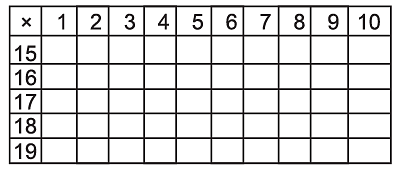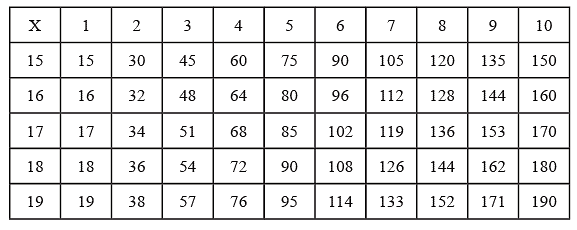Knowing Our Number- 2 Class 6 Worksheet Maths
Ques 1: Fill up the blanks:
(a) Smallest 6-digit number in Indo Arabic Numeration System is __________.
(b) Largest 8-digit number in International Numeration System is
__________.
(c) Expanded notation of 2730145 is __________ .
(d) MDCL in Hindu-Arabic form is written as __________ .
(e) 707 in Roman Numerals can be written as __________ .
Sol: (a) One lakh
(b) Ninety nine million nine hundred ninety nine thousand nine hundred ninety nine.
(c) 2 × 10,00,000 + 7 × 1,00,000 + 3 × 10,000 + 0 × 1000 + 1 × 100 + 4 × 10 + 5
(d) 1650
(e) DCCVII
Explanation:
(a) The smallest 6-digit number in Indo Arabic Numeration System is "One lakh" which is 100,000. In the Indo Arabic system, the 6-digit numbers start from 100,000.
(b) The largest 8-digit number in International Numeration System is "Ninety nine million nine hundred ninety nine thousand nine hundred ninety nine," which is 99,999,999. In the International system, the 8-digit numbers go up to 99,999,999.
(c) The expanded notation of 2730145 is "2 × 10,00,000 + 7 × 1,00,000 + 3 × 10,000 + 0 × 1000 + 1 × 100 + 4 × 10 + 5," which represents each digit's place value in the given number.
(d) MDCL in Hindu-Arabic form is written as 1650. In Roman numerals, M represents 1000, D represents 500, C represents 100, and L represents 50, so MDCL translates to 1000 + 500 + 100 + 50 = 1650.
(e) 707 in Roman Numerals can be written as "DCCVII," where D represents 500, C represents 100, and VII represents 7.
Ques 2: Using 2, 0, 4, 5 write largest and smallest 4-digit number (without repetition).
Sol: Largest number : 5420 Smallest number : 2045
Explanation: The largest number formed using 2, 0, 4, 5 is 5420, and the smallest number is 2045. This is achieved by arranging the digits in descending and ascending order respectively.
Ques 3: Fill up the blanks using > or < signs:
(i) 2347 ________ 2437 ________ 2473 ________ 2734 ________ 2743
(ii) 50725 ________ 50572 ________ 50527 ________ 50275 ________ 50257
Sol:
(i) 2347 < 2437 < 2473 < 2734 < 2743
(ii) 50725 > 50572 > 50527 > 50275 > 50257
Explanation:
(i) 2347 < 2437 < 2473 < 2734 < 2743, indicating the ascending order of the given numbers.
(ii) 50725 > 50572 > 50527 > 50275 > 50257, indicating the descending order of the given numbers.
Ques 4: Add 825432 and 543082 and write the sum according to Indo Arabic Numeration System.
Sol: Sum = 13,68,514 (Thirteen lakh sixty eight thousand five hundred and fourteen.)
Explanation: The sum of 825432 and 543082 is 1,368,514, which is written as "Thirteen lakh sixty eight thousand five hundred and fourteen" in the Indo Arabic system.
Ques 5: Subtract 405235 from 995432 and write the difference according to International system of numeration.
Sol: Difference = 590,197 (Five hundred ninety thousand one hundred ninety seven)
Explanation: The difference between 995432 and 405235 is 590,197, which is written as "Five hundred ninety thousand one hundred ninety seven" in the International system.
Ques 6: If in a garden there are 4592 flowering plants and 3257 fruit trees then what's the total number of plants in the garden?
Sol: Total number of plants = 7849
Explanation: The total number of plants in the garden is obtained by adding the number of flowering plants and fruit trees, which is 4592 + 3257 = 7849.
Ques 7: Evaluate : 81 [15 {7 – 2 (7 – 3)}]
Sol: –1215
Explanation:
Step 1: Solve the expression inside the innermost parentheses:
7−2(7−3)=7−2(4)=7−8=−1
Step 2: Substitute the result into the expression inside the brackets:
15×(−1)=−15
Step 3: Substitute the result into the expression within the outermost brackets:
81×(−15)=−1215
So, the evaluation of the expression results in -1215.
Ques 8: A flask has 5 litres of lemonade. How many glasses, each of 200ml capacity, can it fill?
Sol: Number of glasses = 25
Explanation: The number of glasses the flask can fill is obtained by dividing the total volume of lemonade (5 litres = 5000 ml) by the volume of each glass (200 ml), which gives 5000 / 200 = 25 glasses.
Ques 9: Estimate each of the following using general rule:
(i) 842 + 1245
(ii) 19,643 – 13,775
(iii) 2149 × 493
(iv) 5762 ÷ 287
(v) 439 + 8325 – 387
Ans:
(i) 2,000
(ii) 6,000
(iii) 10,50,000
(iv) 20
(v) 8,000
Explanation:
(i) 842+1245
Round each number to the nearest order of magnitude:
800+1200=2000
(ii) 19,643−13,775
Round each number to the nearest order of magnitude:
20,000−14,000=6000
(iii) 2149×493
Round each number to the nearest order of magnitude:
2000×500=1000000=10,50,000
(iv) 5762÷287
Round each number to the nearest order of magnitude:
6000÷300=20
(v) 439+8325−387
Round each number to the nearest order of magnitude:
400+8000−400=8000
Ques 10: Fill up the blanks:

Ans:

|
92 videos|348 docs|54 tests
|
FAQs on Knowing Our Number- 2 Class 6 Worksheet Maths
| 1. What is the importance of knowing our numbers in mathematics? |  |
| 2. How can knowing our numbers help in everyday life? |  |
| 3. Can knowing our numbers improve problem-solving skills? |  |
| 4. What are the basic concepts included in knowing our numbers? |  |
| 5. How can knowing our numbers help in academic success? |  |

|
Explore Courses for Class 6 exam
|

|


















